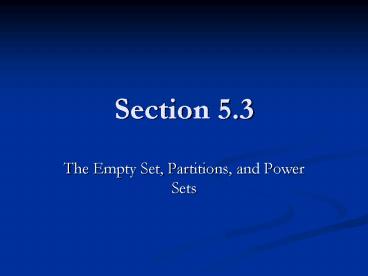The Empty Set, Partitions, and Power Sets - PowerPoint PPT Presentation
1 / 14
Title:
The Empty Set, Partitions, and Power Sets
Description:
The Empty Set, Partitions, and Power Sets. Element Method for Proving a Set Is the Empty Set ... any set A, A AC = . Some Properties Involving. For all sets A, ... – PowerPoint PPT presentation
Number of Views:882
Avg rating:3.0/5.0
Title: The Empty Set, Partitions, and Power Sets
1
Section 5.3
- The Empty Set, Partitions, and Power Sets
2
Element Method for Proving a Set Is the Empty Set
- To prove that a set X is equal to the empty set
?, - Suppose that X has at least one element.
- Derive a contradiction.
3
Theorem For any set A, A ? AC ?.
- Proof By contradiction. Suppose there is a set
A such that A ? AC ? ?. Then there is an element
x such that x ? A ? AC. By the definition of
intersection, this means that x ? A and x ? AC.
By the definition of complement, we know that x ?
A and x ? A. This is impossible, and so is a
contradiction. Therefore, for any set A, A ? AC
?. ?
4
Some Properties Involving ?
- For all sets A, A ? ? A.
- For all sets A, A ? AC ? and A ? AC U.
- For all sets A, A ? ? ?.
- Finally, UC ? and ?C U.
5
Disjoint Sets
- Two sets are called disjoint if and only if they
have no elements in common. - Symbolically A and B are disjoint ? A ? B ?.
6
Theorem For all sets A and B, the sets A B and
A ? B are disjoint.
- Proof By contradiction. Assume there are sets A
and B such that A B and A ? B are not disjoint.
Then (A B) ? (A ? B) has at least one
element. Let x be an element of (A B) ? (A ?
B). By the definition of intersection, this
means that x ? A B and x ? A ? B. Since x ? A
B, x is in A but not in B, and since x ? A ? B,
x is in both A and B. This is a contradiction
because x cannot both be in B and not in B.
Therefore, no such element x exists, so A B and
A ? B must be disjoint. ?
7
Mutually Disjoint Sets
- Sets A1, A2, , An are said to be mutually
disjoint (or pairwise disjoint or nonoverlapping)
if and only if no two sets Ai and Aj with
distinct (different) subscripts have any elements
in common. So.for all i, j 1, 2, , n, Ai ?
Aj ? whenever i ? j. - Example The sets 1, 2, 3, 5, and 4, 7 are
mutually disjoint.
8
Partitions
- A collection of nonempty sets A1, A2, , An is
a partition of a set A if and only if - A A1 ? A2 ? ? An
- A1, A2, , An are mutually disjoint.
- Example Let A 1, 2, 3, 4, 5, 6. Then B
1, 2, C 3, 5, and D 4, 6 is a partition
of A.
9
Power Sets
- Given a set A, the power set of A, denoted P(A),
is the set of all subsets of A. - Example If A a, b, c, then
- P(A) ?, a, b, c, a, b, a, c, b, c,
a, b, c
10
Theorem For all sets A and B, if A ? B, then
P(A) ? P(B).
- Proof Suppose A and B are sets such that A ? B.
Suppose X? P(A). We must show that X? P(B).
Since X? P(A), we have X ? A by the definition of
power sets. But A ? B, so X ? B by the
transitive property of subsets. Therefore, X?
P(B) by the definition of power sets. Since any
element of P(A) is an element of P(B), we have
P(A) ? P(B) by the definition of subsets. ?
11
Theorem for all integers n ? 0, if a set X has n
elements then P(X) has 2n elements.
- Outline of proof
- Well use induction on the number of elements in
X. - We can restate the theorem as Any set with n
elements has 2n subsets. - True for n 0 P(?) ?.
- Assume our restatement is true for n k.
12
Theorem for all integers n ? 0, if a set X has n
elements then P(X) has 2n elements.
- Consider a set X with k 1 elements, and let a
be an element of X. - Every subset of X either contains a or doesnt
contain a. - X - a has k elements, so the number of subsets
of X without a in them is 2k by our inductive
hypothesis. - (Tricky part) Subset of X that do contain a can
be matched exactly with the subsets of X that do
contain a. - Therefore, X has 2(2k) 2k1 subsets.
13
Fridays class
- Start section 7.1.
14
Information About the Test
- The average was about 80.
- The high score was 100.
- The low score was 42.5.































